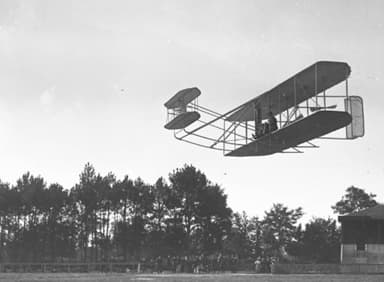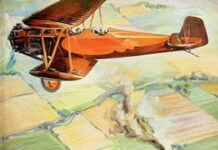Traian Vuia Makes First Flight on a Tractor Airplane (March, 1906)
Traian Vuia, also called Trajan Vuia was a Romanian inventor and aviation pioneer who built the world’s first tractor monoplane. This meant it had the engine mounted behind the propeller so it pulled the aircraft through the air. As opposed to pushing it with an airscrew positioned behind the motor.
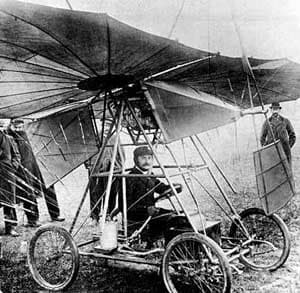
https://en.wikipedia.org/wiki/File:Traian_Vuia_aircraft.jpg
Traian Vuia, also called Trajan Vuia was a Romanian inventor and aviation pioneer who built the world’s first tractor monoplane. This meant it had the engine mounted behind the propeller so it pulled the aircraft through the air. As opposed to pushing it with an airscrew positioned behind the motor.
His high-wing aircraft was made entirely from steel tubing, with the lower part resting on four pneumatic-tired wheels, the front pair steerable. The wing structure itself was a number of curved steel tubes radiating outwards from their centers, braced by wires attached to a pair of king posts, and covered in varnished linen.
Pitch control was achieved by varying the ‘angle of attack’ of the wing. Self-contained propulsion came from liquid carbon dioxide vaporized in a Serpollet boiler and fed to a Serpollet auto engine. This provided enough energy for a five minute flight on full power.
Vuia I was only moderately successful. On March 18, 1906 the vehicle accelerated for about 160 feet. Then it traveled through the air for about 39 feet approximately 3 feet above the ground, before the engine cut out.
Traian Vuia reduced the wind camber, and added an elevator after two more short hops. His creation was unique in that it could take off from a flat surface, without assistance such as an incline, rails, or catapult.The main specification was as follows:
- Length 18.6 ft, height 9.5 ft, span 28.7 ft
- Lifting surface 217 sq ft, engine 25 hp
- Propeller two-bladed seven ft, loaded weight 531 lb
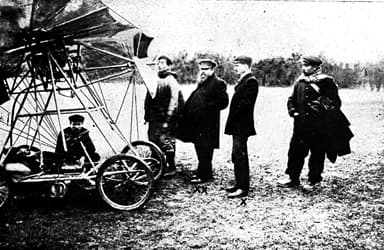
https://commons.wikimedia.org/wiki/Category:Traian_Vuia_(aviation_pioneer)#/media/File:Vuia_I_-_1906_(8).png
Jacob Ellehammer Builds First Radial Engine (September 1906)
Jacob Christian Hansen Ellehammer was a Danish watchmaker and inventor, including of the radial pump. He was unaware of the Wright brothers’ progress, and so worked largely on his own. He began working on a novel multi-cylinder aircraft engine, but was stymied by the weight problem until be hit on the idea of using a common crank.

https://commons.wikimedia.org/wiki/File:Ieyl._stjerneformet_Motor_Standard_Type._50HK._MET_DP213333.jpg
Ellehammer applied his experience of kites in childhood to produce a triangular wing. This radically reduced the weight of the aircraft. In fact, one could say he invented the hang glider, rather than a fixed wing aircraft.
He added a second wing during experiments, tied to the first one with ropes. This ‘sail’ had no framework adding a mere seven pounds to vehicle weight. Stability control was via a pendulum linked to the elevators.
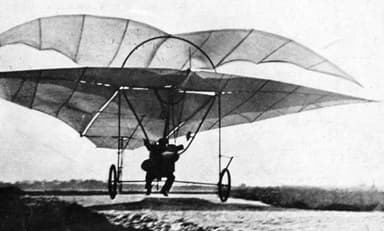
https://www.berlingske.dk/boganmeldelser/manden-der-ville-til-himmels
Ellehammer left a rich legacy of photographs he annotated. The first manned flight lifted off on September 12, 1906, and flew 140 feet, 20 inches off the ground. He made over 200 flights in total without a single crash or mishap. And along the way be created the world’s first runway. Almost as an aside.
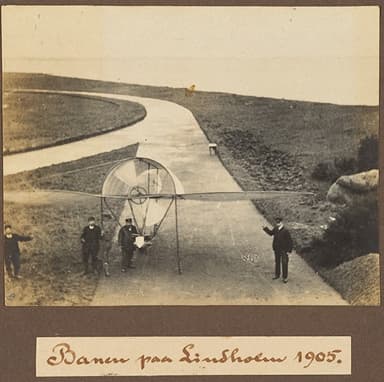
https://commons.wikimedia.org/wiki/File:Banen_paa_Lindholm_1905._MET_DP213316.jpg
Voison Brothers Open First Aircraft Factory Near Paris (1905)
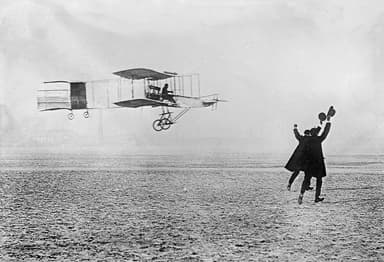
https://en.wikipedia.org/wiki/Voisin#/media/File:Voisin-Farman_I.jpg
Gabriel and Charles Voison established an aircraft factory at Billancourt, Paris France in 1905, that later adopted the name Société Anonyme des Aéroplanes G. Voisin. This was after Gabriel entered into partnership with Louis Blériot with whom he later fell out.
The factory’s first project was the Voison-Farman 1. This was Europe’s first manned, heavier-than-air powered aircraft capable of a sustained half-mile circular, controlled flight, including take-off and landing. Much followed, for this was only the beginning.
Was Santos-Dumont 14-bis First True Aircraft? (November 1906)
Alberto Santos-Dumont was a Brazilian inventor and aviation pioneer. He was one of very few people to contribute significantly to the development of both lighter-than-air, and heavier-than-air aircraft.
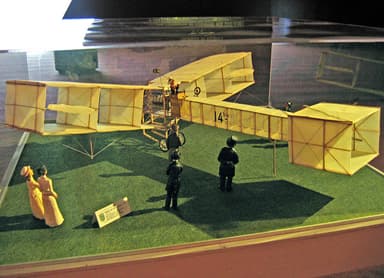
https://en.wikipedia.org/wiki/File:14-bis.JPG
The Santos-Dumont 14-bis was a box-kite biplane with an Antoinette engine. The wings at the rear had a steep dihedral angle between them, to increase lateral stability. The airplane ran on wheels located at the back, with a skid under the front of the fuselage.
The engine, pusher propeller, and pilot were immediately in front of the wings. A movable box-kite-style ‘canard’ cell at the nose – controlled by cables and attached to the pilot’s flight suit – pivoted on a universal joint to control yaw and pitch.

https://www.fai.org/news/12-november-1906-first-flight-santos-dumont
The first successful flights, after a crash two months earlier, took place before the French aviation community acting as witnesses at the Chateau de Bagatelle grounds on November 12, 1906. Later in the day Santos-Dumont flew for 700 feet, 20 feet off the ground for 22 seconds earning a prize.
The specification was as follows:
- Length 31 ft, wingspan 37 ft, wing width 8 ft, wing area 560 sq ft
- Power plant 1 × Antoinette 8V V-8 water-cooled piston engine, 50 hp
- Max speed 25 mph, range flown 0.14 mi, power/mass 0.073 hp / lb
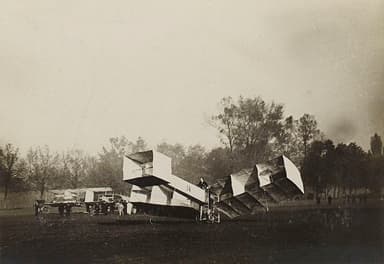
https://en.wikipedia.org/wiki/File:14-bis_de_Alberto_Santos_Dumont.jpg
Louis Blériot Develops an Experimental Monoplane (April 1907)
Louis Blériot was a French aviator, inventor and engineer. His early achievements included combining hand-operated joystick and foot-operated rudder control. And the first working, powered, piloted monoplane discussed here.

https://en.wikipedia.org/wiki/File:Bleriot_V.jpg
Blériot V was a monoplane with a braced wooden box-girder fuselage covered with varnished silk. The wings made of wood painted with varnish had no bracing, meaning they could be folded upwards for transportation. The main undercarriage was a pair of bicycle wheels.
The aircraft first flew on April 5, 1907. However, it only traveled 20 feet after a run-up of 305 feet. This was after Blériot cut the engine and landed when he became concerned about his ability to control the aircraft in the stiff breeze that was blowing. The aircraft was written off during a subsequent attempt from which Blériot survived, unharmed.

https://www.agefotostock.com/age/en/Stock-Images/Rights-Managed/MEV-10843936
Horatio Phillips: First UK Heavier than Air Flight (April 1907)
It’s difficult to comprehend Horatio Phillip’s multiplane flying machine at first ,because it defies what went before, and followed. A good start would be to imagine 50 narrow lifting surfaces in a ‘venetian blind’ configuration with four of those sets in a row.
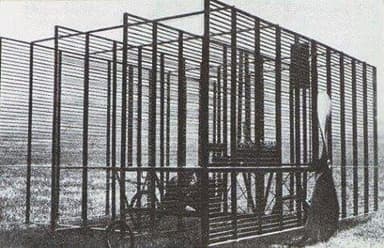
https://www.pinterest.ch/pin/466826317620470585/?amp_client_id=CLIENT_ID(_)&mweb_unauth_id={{default.session}}&from_amp_pin_page=true
The inventor / aviator had several failed attempts with single stack versions, before his multi-stacker flew 500 feet on April 6, 1907. However, this did not compare well with other contemporary aircraft, causing the inventor to build another one, with 500 wings on another occasion.
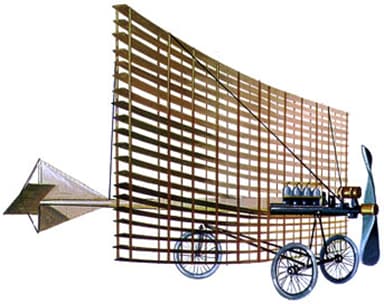
http://www.fiddlersgreen.net/models/aircraft/Phillips-Multiplane.html
Bréguet Brothers Attempt First Helicopter (September 1907)
The Bréguet brothers designed a gyroplane with some assistance from Charles Richet during 1906 / 1907. This was one of the earliest experiments to create a practical rotary-wing aircraft.
It comprised an open steel framework supporting the pilot’s seat and four wire-braced tubular steel arms. Each of these carried a superimposed pair of four-bladed rotors. Two were driven in each direction to eliminate torque effect.
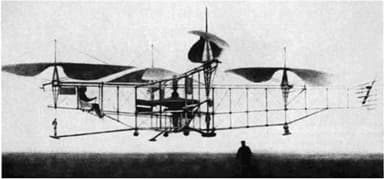
https://alchetron.com/Breguet-Richet-Gyroplane
The Gyroplane first lifted 2 feet off the ground on September 29, 1907, albeit with four men steadying the structure with poles, because it was neither controllable nor steerable. However, it later flew 5 feet above the ground although it is not clear whether this was an independent flight.
The specification was as follows taken from 2 sources:
- Main rotor area 4,329 sq ft, main rotor diameter 4 x 26 ft, height 12 ft
- Propulsion 1 × Antoinette water-cooled piston engine, 46 hp
- Gross weight 1,100 lb, service ceiling 2 ft, endurance 1 minute
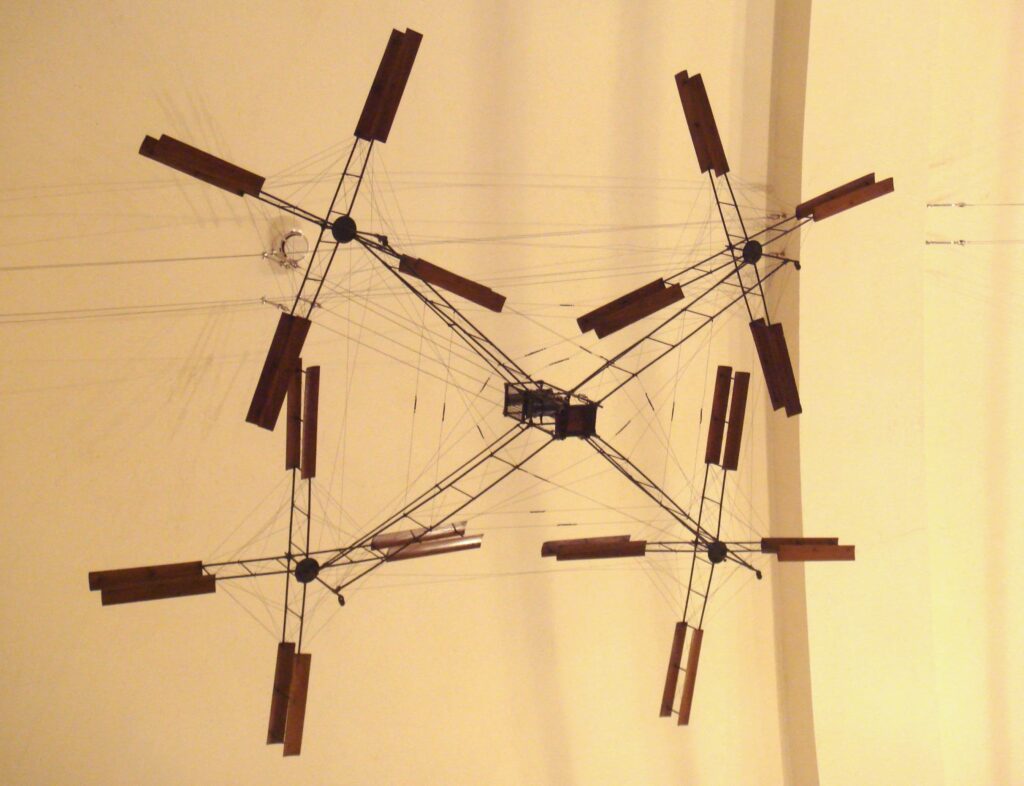
https://upload.wikimedia.org/wikipedia/commons/d/d3/Breguet_Gyroplane_1907.jpg?download
Blériot VII, First Tractor Monoplane Flies (November 1907)
Louis Blériot began taxying trials of his revolutionary aircraft at Issy-les-Moulineaux on October 5, 1907. The rear wing of his new version was half the span of the forward one, as was the case in the vast majority of other aircraft. The tail surfaces could act as elevators together, or independently as elevons working as stabilizers.
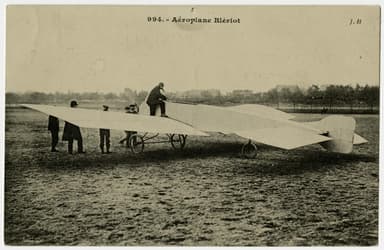
https://airandspace.si.edu/collection-objects/ble%CC%81riot-vii-photograph
The first successful flight of Blériot VII on November 16, 1907 covered a distance of 1,600 feet. Towards the end of the month Blériot moved the wings from immediately above the lower stringers to a position about two thirds of the way up the fuselage. He also added additional structural support for wing-bracing wires.
On December 6, 1907 Louis Blériot succeeded in making a U-turn in the air. British aeronautical pioneer Patrick Alexander was sufficiently impressed to remark ‘I think Blériot is now leading the way’. However, the same cannot be said for his revolutionary aircraft. On December 19 the left wheel collapsed, digging in the wing and destroying the airplane.
The specification was as follows:
- Length 29 ft, wingspan 36 ft, wing area 270 sq ft, crew 1
- Gross weight 937 lb, propulsion by Antoinette V-8 piston engine, 50 hp
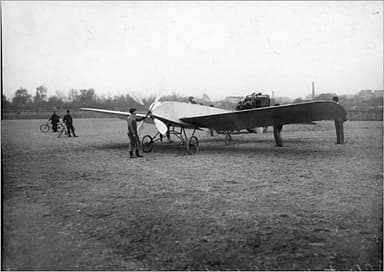
https://www.prints-online.com/royal-aeronautical-society/photographic/louis-bleriot-bleriot-vii-issy-november-1907-9897659.html
Peter Cornu Achieves First Rotating Wing Flight (November 1907)
Peter Cornu was a French engineer of Romanian origin who made bicycles. He was one of thirteen children and worked in his father’s transport company from an unknown early age. In 1907, at age 26 he achieved the first untethered flight in a rotating-wing aircraft.
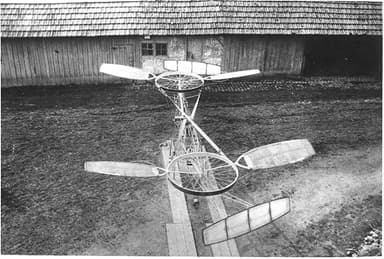
http://www.helistart.com/helicopters/Paul_Cornu/Helicopter
Peter Cornu’s ‘helicopter’ was an improvement over the Breguet-Richet Gyroplane I, in that it flew under its own power without additional support. It hovered one foot above the ground for 20 seconds on November 13, 1907. However, it was scarcely maneuverable and so the inventor returned to business as usual, making bicycles.
The known specification was as follows:
- Propulsion 24 horsepower Antoinette engine
- Wings 2 x belt-driven twenty-foot rotors

https://en.wikipedia.org/wiki/Paul_Cornu#/media/File:HE2G13.jpg
First Specification for a U.S. Army Aircraft (December 1907)
The United States Army created an Aeronautical Division within the office of the chief of its Signal Corps on August 1, 1907. On December 23 of that year the Signal Corps issued Specification No. 486 for a heavier-than-air flying machine and requested bids.
The specification was as follows:
- Capable of carrying 2 passengers with a combined weight of 350 lb
- Minimum top speed 40 mph, range of at least 125 statute miles
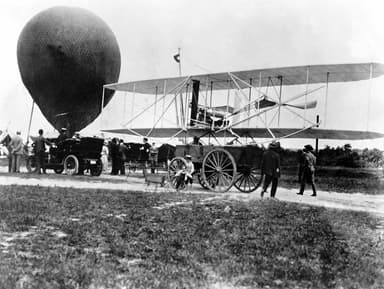
https://en.wikipedia.org/wiki/Aeronautical_Division,_U.S._Signal_Corps#/media/File:Wright_Military_Flyer_arrives_at_Fort_Myer_VA_DA-SD-05-00659.JPEG
First Public Display of Powered Aircraft Flight in U.S. (March 1908)
A Canadian-American Aerial Experiment Association had formed on September 30, 1907 under leadership of Alexander Graham Bell. The AEA produced different aircraft in quick succession, with each member acting as principal designer for at least one. Notable innovations included wingtip ailerons and tricycle landing gear
Thomas Selfridge, a first lieutenant in the U.S. Army commissioned the AEA to construct a powered aircraft to his design. It acquired the name Red Wing because of its reddish fabric sealant, which also achieved the best result with the photographic materials and techniques of the day.
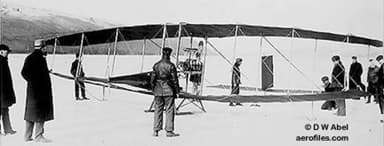
http://www.aerofiles.com/aea.html
The first public air flight in the United States took place on frozen Keuka Lake near Hammondsport, New York on March 12, 1908. Red Wing took off and covered 319 feet before crashing 20 seconds after take-off, and killing the pilot. A portion of the tail had apparently broken from the strain.
The specification for Red Wing was as follows:
- Length 26 feet, wingspan 43 feet, landing gear steel skids
- Propulsion Curtiss B-8 air-cooled V8 engine, 40 hp
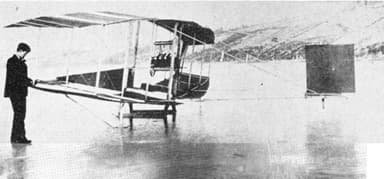
https://en.wikipedia.org/wiki/File:AEA_Red_Wing_(Aerodrome_1).jpg
Glenn Curtiss Achieves Longest Public Flight in U.S. (July 1908)
Glenn Curtiss was also a member of the Canadian-American Aerial Experiment Association. Scientific American awarded him a trophy for making the first U.S. public flight of over 1 km (0.62 miles) at Hammondsport, at the south end of Keuka Lake near New York.
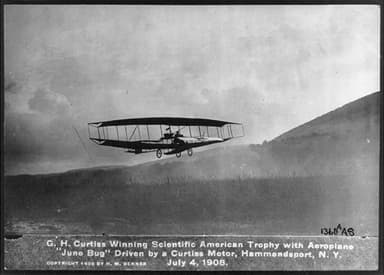
https://en.wikipedia.org/wiki/File:Curtiss_june_bug.jpg
The June Bug acquired its name from an American beetle with large stiff outer wings for gliding, and more delicate smaller propeller-like wings that did the actual propulsion. Crowds flocked to view the demonstration along with reporters, photographers, and a motion picture film crew.
The first attempt was a false start. However, on the second one Curtiss flew 5,360 ft (1.6 km) in 1 minute 40 seconds, winning the trophy and a US$25,000 cash prize. There was great excitement, and some celebration after the wine cellars reopened their doors with free champagne for all.
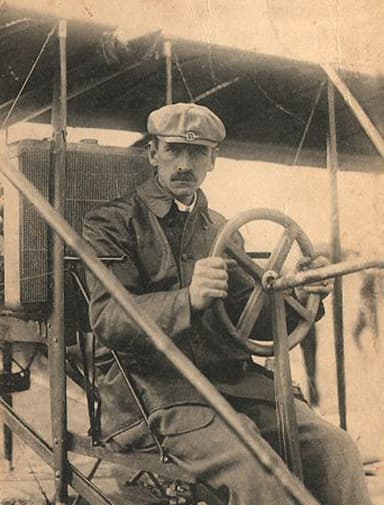
https://en.wikipedia.org/wiki/File:Glenn_Curtiss_in_His_Bi-Plane,_July_4,_1908.jpg
The specification for June Bug was as follows:
- Length 27 ft, wingspan 42 ft, maximum speed 39 mph
- Propulsion Curtiss B-8 V-8 air-cooled piston engine, 40 hp
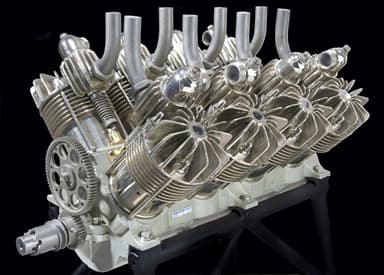
https://airandspace.si.edu/collection-objects/curtiss-b-8-v-8-engine/nasm_A19490009000
Wright Flyer 1 Astounds Crowds in France (February 1908)
The Wright Brothers stopped flying publicly in 1905 because they were concerned other people might steal their ideas. Their disappearance caused some to believe they had never flown an airplane. To counter this, they brought Flyer 1 to France to prove their case.
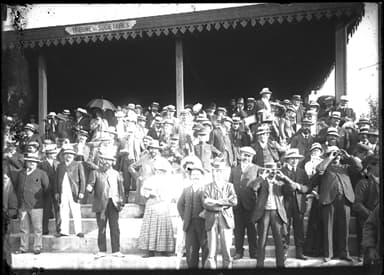
https://artsandculture.google.com/asset/crowd-awaiting-demonstration-flights-by-wilbur-wright-hunaudieres-race-course-le-mans-france-august-1908-bollee-leon-1870-1913/TQEgWLAjkJNNyg?hl=en&ms=%7B%22x%22%3A0.5%2C%22y%22%3A0.5%2C%22z%22%3A9.391767719955997%2C%22size%22%3A%7B%22width%22%3A0.9634146341463414%2C%22height%22%3A1.25%7D%7D
However, their exhibition flights were delayed for months after French customs officials uncrated Flyer 1 causing considerable damage. When Wilbur finally took off, the skeptics fell silent as they watched ‘a series of spectacular demonstration flights’. These would have a profound effect on European aviation during the following months.
Levavasseur Completes First Circle for Monoplanes (August 1908)
Léon Levavasseur was a French power plant engineer, aircraft designer and inventor associated with the Antoinette company. He developed the experimental Gastambide-Mengin / Antoinette II monoplane working with financier Jules Gastambide, and aircraft engineer Gabriel Mengin.
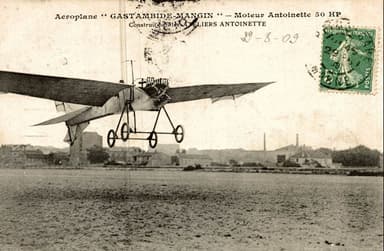
https://en.wikipedia.org/wiki/File:Aeroplane_Gastambide_Mangin,_Antoinette.jpg
Antoinette II was a successful aircraft completing four flights between 8 and 14 February 1908. Following modifications to trailing ailerons, it flew again in August, in the process completing the first circle by a monoplane on August 21, 1908.
The specification was as follows:
- Length 26 ft, wingspan 32 ft, wing area 258 sq ft
- Complex quadricycle landing gear arrangement
- 50 hp Antoinette piston engine / tractor propeller
- Maximum take-off weight 772 lb with one crew
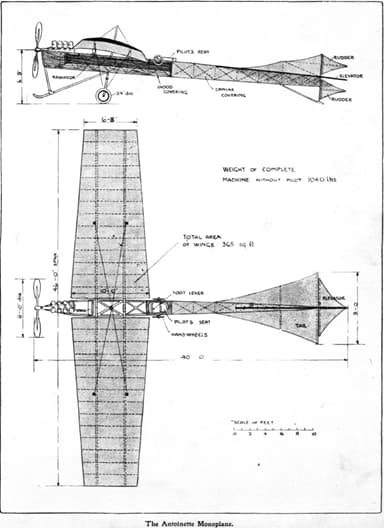
https://www.thisdayinaviation.com/tag/mlle-antoinette-gastambide/
Wright Brothers Model A – World’s First Production Airplane (1908)
The Wright Brothers had been working on a Model A version since 1907, but accelerated development when the U.S. Army began actively seeking a supplier. This was a further development of their Flyer III with 35 hp engine, dual seating, and new control systems.
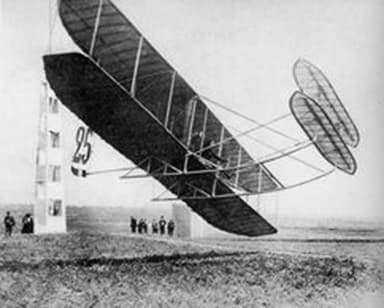
http://www.wright-brothers.org/Information_Desk/Just_the_Facts/Airplanes/Model_A.htm
The ‘Wilbur Method’ – as Smithsonian’s National Air and Space Museum refers to it – controlled the roll and yaw controls on the same lever at the pilot’s right hand. A forward-backward movement controlled the rudder, while a sideways or left-and-right motion controlled wing-warping.
Whereas with the ‘Orville Method the stick controlled wing warping, while a knob atop the stick controlled the rudder. But in both methods the left-hand lever operated the forward elevator to control pitch.
The specification of the Model A Flyer was as follows:
- Length 30 ft, height 8 ft, wingspan 36 ft, 2 crew, gross weight 1,236 lb
- Propulsion Wright Vertical 4-cylinder water-cooled in-line piston engine, 35 hp
- 2-bladed painted spruce elliptical propellers, maximum speed 42 mph

https://en.wikipedia.org/wiki/Wright_Vertical_4#/media/File:Wright_Vertical_Four_2.JPG
Orville Wright Sets New Records for Model A (September 1908)
Orville Wright must have developed his flying skills and confidence during U.S. Army trials that followed, for he achieved the following results in September 1908:
- September 9 – Flight endurance of one hour two minutes solo
- September 9 – Flight endurance of six minutes with a passenger
- September 10 – Flight endurance of one hour five minutes solo
- September 11 – Flight endurance of one hour ten minutes solo
- September 12 – Flight endurance of nine minutes with a passenger
The series of tests ended tragically the following day, when the aircraft broke a propeller in flight, and fell to the ground from an altitude of 75 feet . Passenger Lieutenant Thomas Etholen Selfridge became the first person killed in a powered aircraft crash, and the first military aviation casualty. Orville Wright suffered serious injuries.
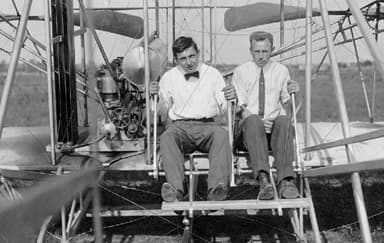
http://www.wright-brothers.org/Information_Desk/Just_the_Facts/Airplanes/Model_A.htm
First Female Aviator, First Love on an Airplane ( September 1908)
French aviator Therese Peltier was in love with two things. These were flying, and her soulmate aviation pioneer Leon Delagrange. Therese was the first woman to take to the air when Leon took her for a flip in his 1907 Voison biplane, Delagrange 1 on July 8, 1908.
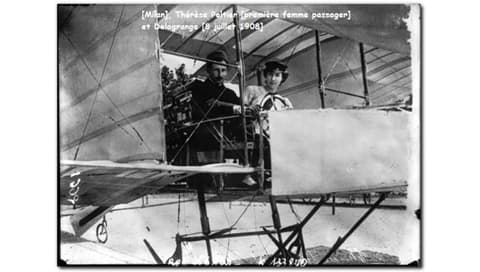
http://jdasolutions.aero/blog/therese-peltier/
In September, 1908 Therese Peltier made a solo flight in the Voisin airplane herself. On a later occasion, she made a solo flight 7 feet off the ground in Turin, confirming a claim she was the first female fixed wing pilot.
And then, alas her beloved Leon died in an aircraft accident on January 1, 1910. She wrote ‘I am mired in my sorrow, lost, destroyed. … He was my childhood friend, my master of art, the strength and balance of my life’. Therese never flew like a bird again.
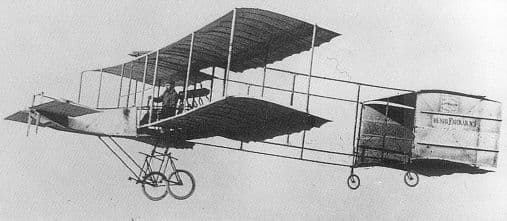
https://shells-tales-sails.blogspot.com/2016/04/p-is-for-therese-peltier-pioneer-women.html
British Army Airplane 1 Makes First Powered UK Flight (October 1908)
The United Kingdom military were skeptical of the Wright Brothers’ claims of achieving sustained controlled flight. In fact their first military aircraft, dirigible Nulli Secundus only appeared in 1907, although there were secret experiments with gliders.
Then, in late 1907 the Director of Fortifications sanctioned the construction of Airplane 1, under management of American Samuel Franklin Cody, who was at that time in the country advising on the Nulli Secundus dirigible.
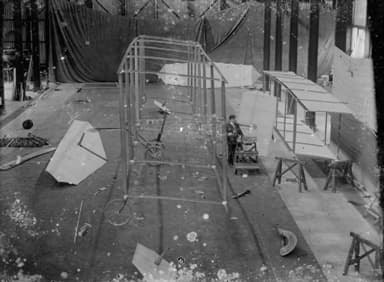
https://en.wikipedia.org/wiki/File:British_Army_Aeroplane_No.1_under_construction.jpg
British Army Airplane 1 followed the Wright Brothers’ principles, being a three bay biplane with horizontal control surfaces mounted in front of the wings, and a rudder behind. However, it was somewhat larger with a wingspan of 52 feet. It also had a tricycle-wheeled undercarriage, plus small wheels mounted on the leading edge on the lower wingtips.
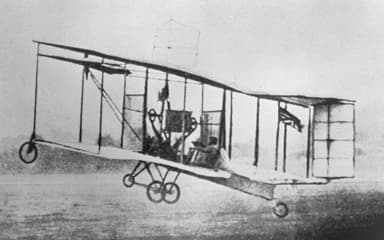
https://en.wikipedia.org/wiki/File:British_Army_Aeroplane_No_1_in_flight_Oct_1908_IWM_RAE-O_995.jpg
The aircraft landed badly after the first flight on October 16, 1908. It flew a number of times after that after modifications to rudders, and replacement of the Antoinette engine with a 60 hp ENV Type F.
The UK authority ended the project in February 1909 after deciding to leave airplane development to the private sector. Cody kept the aircraft. All the government had for its trouble was a set of drawings labelled ‘TOP SECRET’’.
The original specification was as follows:
- Length 38 feet. Height 13 feet, wingspan 52 ft, wing area 640 sq ft
- Original propulsion Antoinette 50 hp, maximum speed 65 mph
Wilbur Wright Wins Michelin Trophy for 76 miles Flight (December 1908)
French tire company Michelin en Cie awarded an International Michelin Trophy starting 1908 to the annual holder of the Aéro-Club de France record. Wilbur Wright completed 1908 in triumph, by claiming the trophy after completing a 76.6 mile flight in 2 hours 18 minutes taking off at Camp d’Auvours in France.
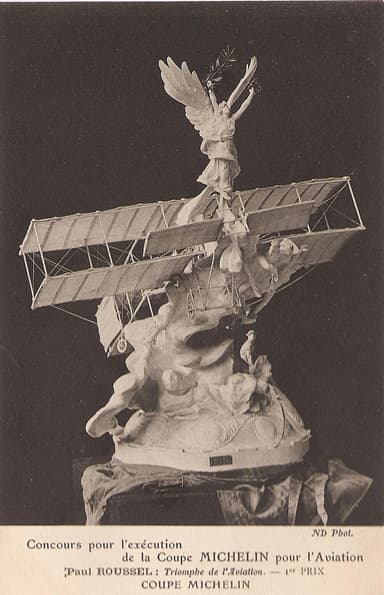
https://en.wikipedia.org/wiki/Michelin_Cup#/media/File:Coupemichelin.jpg
The award-winning flight took place on December 31, 1908. The 1907 Wright Flyer covered a distance of 77.48 miles in 2 hours, 20 minutes, 23 seconds, following a triangular route and setting a record for duration and distance. Michelin Trophy awarded Wilbur the ₣20,000 prize.
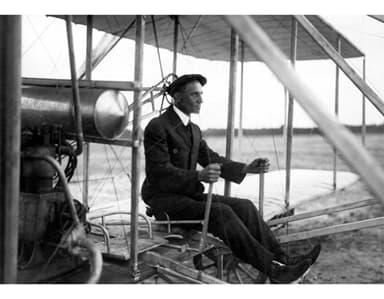
McCurdy Makes First Powered Flight in Canada (February 1909)
Aerial Experiment Association members Glen Curtiss, Frederick Baldwin, and John McCurdy built an experimental aircraft, AEA Silver Dart in 1908. This made a number of successful flights in the United States. However, Canadian John McCurdy had his eyes on the Canadian Army, and was determined to prove its potential as a military machine.

https://en.wikipedia.org/wiki/John_Alexander_Douglas_McCurdy#/media/File:John_A.D._McCurdy.jpg
McCurdy had difficulty convincing a skeptical Canadian Army that aircraft could contribute much in actual warfare. However, he was finally invited to demonstrate the AEA Silver Dart in February 1909. The terrain at Petawawa in Ontario was sandy, making a poor landing strip for an airplane with wheels just two inches wide.
The aircraft struggled to take off, but did complete the first four powered flights in Canada, beginning on February 23, 1909. But on the fifth flight on August 2, 1909, a wheel struck a rise in the ground while landing. That Silver Dart was wrecked. She never flew again.

https://commons.wikimedia.org/wiki/File:AEA_Silver_Dart.jpg
The specification of the aircraft was as follows:
- Length 30 ft, height 9 ft, wingspan 40 ft, wing area 563 sq ft
- Propulsion Curtiss V-8 hp, air-cooled piston engine
- Engine later converted to water cooling by McCurdy
- Empty weight 320 lb, max speed 40 mph, range 20 miles
First All-British Powered Aircraft Flies on Walthamstow (July 1909)
The Walthamstow Marshes where Edwin Alliott Verdon Roe launched his first flight are a flatland once used for growing crops and grazing cattle for the community. Roe designed and built his Roe 1 (also known the Avro Triplane) following a two-bay triplane wing design. The tail plane followed suit making it more a lifting than a stabilizing device.

https://www.skytamer.com/Avro_09_Triplane.html
Pitch control was by altering the angle of incidence of the main planes, and lateral control by wing-warping. While directional control was achieved by a rectangular rudder mounted behind the tail plane.
The engine was below the leading edge of the wing, with a belt drive to the propeller drive shaft which was mounted above the upper longeron stringers. Following taxiing trials, Roe replaced the 6 horsepower JAP engine with a more powerful 9 horsepower version.
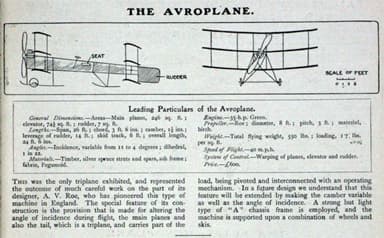
https://www.gracesguide.co.uk/Roe_I_Triplane
By June 5, 1909 the replacement engine was commissioned, and Roe began a series of brief flights over a distance of 50 feet. Then on July 13 he flew 100 feet after tinkering with different reduction ratios between the engine and propeller, and also with varying pitch settings for the propeller blades.
The specifications of the first British powered airplane were as follows:
- Length 23 ft, wingspan 20 ft, height 9 ft, wing area 320 sq ft
- Empty weight 300 lb, gross weight, 450 lb
- Propulsion JAP V-twin configuration air-cooled, 9 hp
- Maximum speed 25 mph, range 0.3 miles
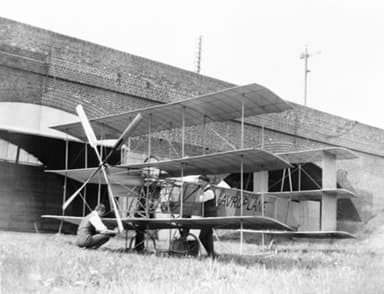
https://www.ssplprints.com/image/1106761/roe-triplane-1909
Bleriot’s First Flight Across The English Channel (July 1909)
Louis Bleriot was a French inventor, innovator and aviation adventurer who used his first practical automobile headlight to finance his first love, flying. He began experimenting after seeing Clément Ader’s Avion III at the 1900 Exposition Universelle.
Bleriot commissioned Gabriel Voisin to build his first airplane after watching his float-plane glider trials on June 8, 1905. Thus began the series of events that culminated in his first, winged wing powered flight across the English Channel on July 25, 1909.
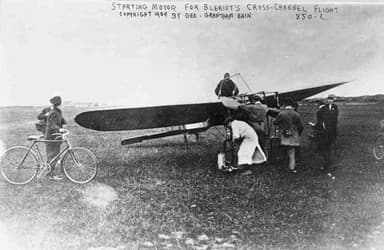
https://en.wikipedia.org/wiki/File:Bleriot_pre-takeoff-25_July_1909.jpg
Bleriot and Voison entered into a partnership to build powered aircraft in 1905. They had several false starts, but a few successes including the 1909 Institute de France Prix Osiris award for making the greatest contribution to science in the previous three years.
On July 25, 1909 Louis Bleriot told the British Daily Mail newspaper he hoped to win their thousand-pound prize for the first successful crossing of the English Channel in a heavier-than-air aircraft, and was about to depart. However, he was nearly pipped to the post by French aviator Hubert Latham.
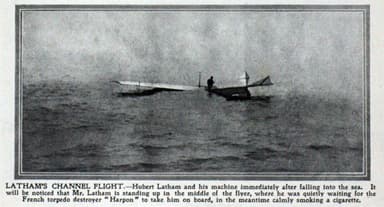
https://www.gracesguide.co.uk/File:Im1909FL-Latham10.jpg
Hubert Latham was the first person to attempt the crossing in the hope of claiming the Daily Mail prize on July 19, 1909. However, his Antoinette IV suffered engine failure when almost half-way across the water, and Latham performed the first landing of an aircraft on the sea.
The salvage operation caused substantial damage to the aircraft. As Latham waited for a new machine to be made ready before making his next attempt, Louis Blériot announced his intention to make a bid for the prize six days later.

https://www.thisdayinaviation.com/tag/mlle-antoinette-gastambide/
On the day, Louis Bleriot was more successful. He rose at dawn on July 25, 1909 and set off at 4:41 to attempt the crossing from France as the sun peeked over the horizon. He accelerated to 45 miles per hour and rose to an altitude of 250 feet following his wife on a French Navy destroyer.
He was lost in the mist for a while, until the English coast came in sight on his left. Bleriot had not visited Dover previously. However he spotted a compatriot waving the French Tricolor flag, and pancaked down in gusty wind over cliffs, shattering one blade of the propeller. The flight had taken 36 minutes and 30 seconds, the record was his, and he was unharmed.
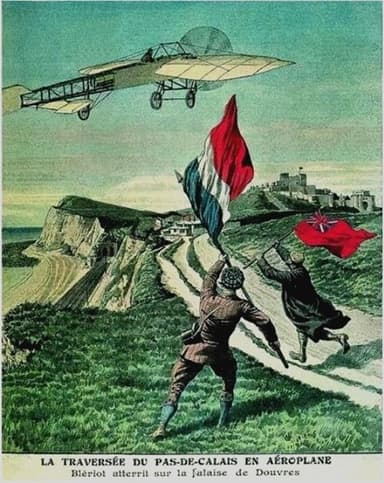
https://en.wikipedia.org/wiki/File:Louis_Bl%C3%A9riot_1909.JPG
Wright Brothers Supply First U.S. Army Airplane (October 1909)
The U.S. Army issued Specification No. 486 for a heavier-than-air flying machine on December 23 1907, and requested bids. The specification for proposals was the aircraft should be able to:
- Carry 2 passengers with a combined weight of 350 pounds
- Reach a 40 mph top speed, and have a range of 125 miles
In August 1908 the Wright Brothers brought their proposed Wright Military Flyer to the Fort Myer parade grounds, Virginia, near Arlington National Cemetery for flight trials.

https://www.defense.gov/Explore/Features/story/Article/1919399/110-years-ago-the-us-military-got-its-first-airplane/
All did not go smoothly at first. One of the Aeronautical Division’s first lieutenants, Thomas Selfridge died after a wooden propeller broke on September 13, and the aircraft fell to the ground. After Orville recovered from serious injuries the brothers returned with a new, improved version.
There were no flying instruments to guide pilots in those pioneering days. All Orville had as a ‘compass’ was an eight-inch piece of string tied to the crossbar between the two skids. This served as a crude turn-and-bank indicator, depending on which direction it blew.
In late October, 1909 the Wright Military Flier proved itself during the final flight test, with first lieutenant Benjamin Foulois from the Aeronautical Division in the passenger seat.
They maintained an altitude of 400 feet and averaged 42.5 miles per hour before landing smoothly. The U.S. Army was well pleased. It bought the aircraft for $30,000 within three days. The battle for control over skies had begun.
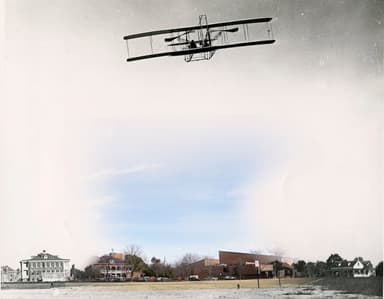
https://www.defense.gov/Explore/Features/story/Article/1919399/110-years-ago-the-us-military-got-its-first-airplane/
Germany Catches Up With Heavier Than Air Flight (August 1909)
Germany seems to have adopted a wait-and-see approach. However, Hans Grade saw opportunities he was determined to seize. He produced the first successful heavier-than-air aircraft in Germany, and around 80 were eventually built.
The Grade Monoplane had a high wing design with the pilot sitting beneath it. An elongated cruciform tail unit attached to the end of a single boom by a universal joint immediately behind the single tailwheel. Lateral control was by wing warping.
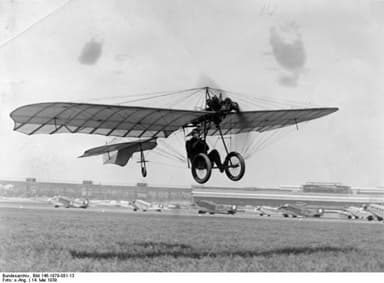
https://en.wikipedia.org/wiki/File:Bundesarchiv_Bild_146-1979-081-13,_Berlin,_Hans_Grade_bei_seinem_Geburtstagsflug.jpg
The first flight took place on August 17, 1909. Grade later won the Lanz Prize of 40,000 marks for the first German-built airplane to fly in a figure 8 round two markers a kilometer apart.
He used the money to establish an aircraft manufacturing business and flying school at Bork, near Magdeburg. The price per aircraft of 12,000 marks included flying instruction. The Japanese army purchased one. This was the first airplane to be flown in Japan.
The specification of the aircraft was as follows:
- Wing span 33 ft, wing area 270 sq ft, crew one, gross weight 441 lb
- Grade air-cooled V-4 two-stroke piston engine, 16 hp, max speed 37 mph
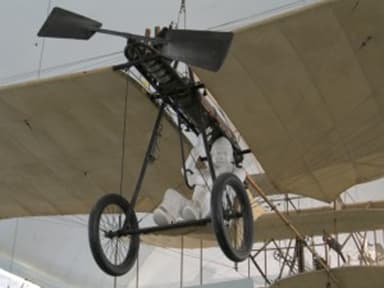
http://www.deutsches-museum.de/en/collections/transport/aeronautics/propeller-planes/up-to-1918/grade/
Grande Semaine d’Aviation de la Champagne (August 1909)
The Grande Semaine d’Aviation de la Champagne near Rheims in France was further proof aviation was entering a more formal phase. The Gordon Bennett trophy was followed by a number of other aviation events, and no doubt many champagne toasts during the period August 22 to August 29, 1909.
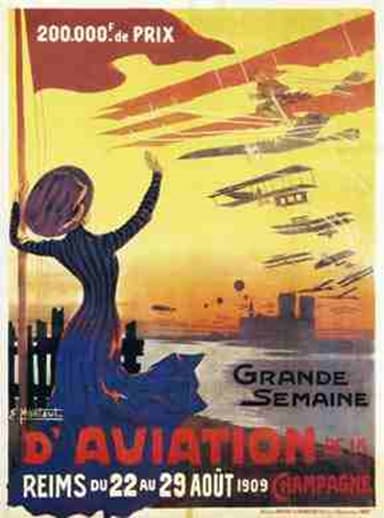
https://en.wikipedia.org/wiki/File:Grande-Semaine-poster.jpg
The half million visitors included the President of the French Republic and the British Chancellor of the Exchequer. A special grandstand was constructed for the crowd gathering to celebrate the coming of age of heavier than air flight

https://en.wikipedia.org/wiki/Grande_Semaine_d%27Aviation_de_la_Champagne#/media/File:Aviatiker-Woche_Reims_1909.jpg
Glenn Curtis Wins First Gordon Bennett Cup Trophy ( August 1909)
New record airplane speeds kept piling up during this period. On 7 August, 1909 Roger Sommer remained in their air for 2 hours, 27 minutes, while on the 26th of that month an Antoinette IV with unknown pilot apparently flew 96 miles in 2 hours 17 minutes. Then Henri Farman raised the distance record to 110 miles.
However, those pilots were all flying on their own, and without direct competition to spur them on. The Gordon Bennett Trophy awarded by the founder and publisher of New York Herald newspaper added the spark, by recognizing the fastest time over a measured distance under competition.

https://en.wikipedia.org/wiki/File:La_coupe_Gordon-Benett.jpg
The first competition took place at the Grande Semaine d’Aviation at Reims in France. This was part of an eight-day event, itself sponsored by local champagne growers and comprising two laps of a six-mile circuit. However, this distance was subsequently extended as aircraft grew faster.
American Glenn Curtiss claimed the trophy on August 28, 1909 in a Curtiss 2 aircraft. This was after completing the 12-mile challenge in 15 minutes 60 seconds at an average speed of 46.7 miles per hour. This was 5.6 seconds ahead of Louis Blériot.

https://en.wikipedia.org/wiki/File:Curtiss_France.jpg
The specification of the Curtis 2 aircraft was as follows:
- Length 30 ft, wingspan 34 ft, crew 1, 2-bladed pusher propeller
- Propulsion Curtiss V-8 water-cooled piston engine, 63 hp
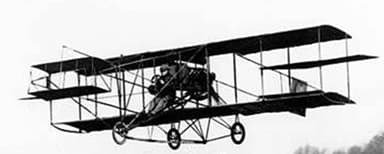
https://en.wikipedia.org/wiki/File:C_K_Hamilton%27s_first_flight_at_The_Meadows_1910-03-11_detail.jpeg
Geoffrey De Havilland Enters Race with Biplane 1 (December 1909)
Geoffrey de Havilland was an English aviation pioneer and aerospace engineer. He achieved remarkable success with his Mosquito multirole combat aircraft, and Comet jet airliner. However, like many early pioneers he got off to a bumpy start, unintended.
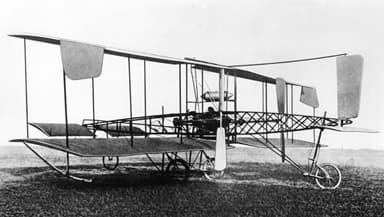
https://www.baesystems.com/en/heritage/de-havilland-no1-biplane–1909-
De Havilland borrowed £1,000 from his maternal grandmother to bankroll his first project. He, his partner Frank Hearle and his new wife Louise built a 3 bay, open-truss biplane in a rented workshop. The Iris Car Company provided the bespoke 45 hp de Havilland Iris flat-four engine.
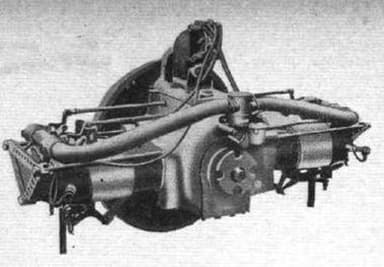
https://en.wikipedia.org/wiki/De_Havilland_Iris#/media/File:De_Havilland_Iris.JPG
De Havilland placed the fin and stabilizer at the rear, while positioning a large elevator at the front of the aircraft. Twin ailerons near the wingtips provided lateral control, in itself an interesting innovation.
Alas, the path to invention is never smooth. Hearle sent the prototype with de Havilland at the controls rolling down a slope on a day in December 1909. But a wing broke shortly after becoming airborne briefly, destroying the aircraft. De Havilland used the remains to build Biplane No 2 which flew successfully in September 1910.
The specification of Biplane No 1 was as follows:
- Length 29 ft, wingspan 36 ft, wing area 408 sq ft, gross weight 850 lb
- 45 hp de Havilland Iris flat-four engine driving twin pusher propellers
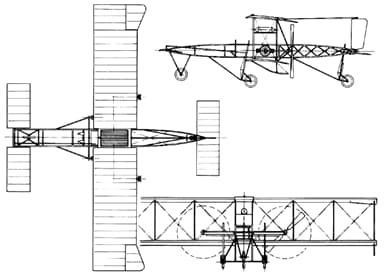
http://www.aviastar.org/air/england/havilland-1.php
Fixed Wing Aircraft Begin to Explore a Military Role in 1910
Fixed wing, powered aircraft had established themselves as reliable machines, although the experimenting continued. Blimps and dirigibles were way ahead in military applications, but airplanes had lagged behind to date.
The second decade of the twentieth century saw the beginning of a new arms race for control of the skies. The world would experience the deadly consequences later. However, for now the start was tentatively experimental.
German inventor August Euler was a pioneer German aviator, aircraft constructor and the holder of the first German pilot’s license issued in 1909. On an uncertain date in 1910 he registered a drawing for a fixed, forward-firing machine gun shooting through an aircraft propeller. But Euler did not take his idea further.
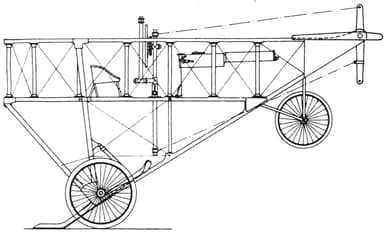
https://en.wikipedia.org/wiki/Synchronization_gear#/media/File:Euler_Gun_Patent_(1910).jpg
In Germany, the Kaiser’s younger brother Admiral Prince Heinrich of Prussia learned to fly. He supported the cause of naval aviation as the Imperial German Navy began to form an air arm.
The Imperial Russian Navy ordered its first aircraft. Three months later it sent three officers to France to receive flight training. In America, United States Army Lieutenant Paul W. Beck dropped sandbags simulating bombs over Los Angeles, California, demonstrating the concept was sound.
Claude Graham-White Meets U.S. Secretary of War (March 1910)
Claude Graham-White was an English aviation pioneer inspired by Louis Blériot’s flight across the English Channel the previous year. He was greatly interested in commercial and military applications. His Grahame-White Aviation Company went on to build a large number of successful aircraft.
On March 7, 1910 Claude Graham-White landed his Farman III Biplane on West Executive Avenue in Washington, D.C. and then had lunch with United States Secretary of War Jacob M. Dickinson. On October 14, 1910 he followed up by landing on West Executive Avenue near the White House.
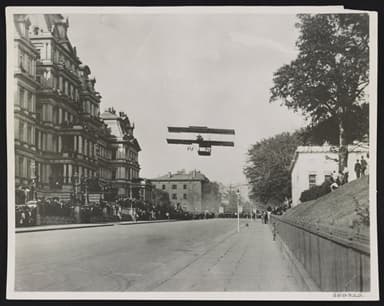
https://www.loc.gov/item/2001705761/
J W Dunne Flies an Inherently Stable Aircraft (March 1910)
Inherent stability is the tendency of an aircraft to return to straight and level flight, when the controls are released by the pilot.
Modern longitudinal / directional stability are under the influence of these three factors:
1… The location of the center of gravity relative to the nose and tail
2… The proximity of the center of pressure to the center of gravity
3… The ability of the tail plane especially elevator to control pitching
Modern lateral stability is under the influence of two other factors:
1… Upward inclining wings to control the rolling effect with counter forces
3…Swept back wings where side-slip causes more lift on the lower wing
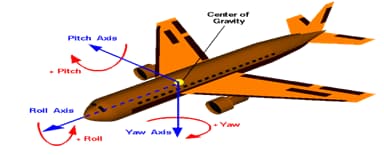
https://www.infohas.ma/en/aircraft-stability-and-control/
However, John William Dunne, British soldier, aeronautical engineer and philosopher did not know about many of those features. Most of his designs had unusual tailless, swept back configurations instead. They achieved their stability by progressively rolling the leading edge down from root to tip, a feature known as washout.
John Dunne flew his first successful tailless aircraft, the Dunne D.5 on March 11, 1910. This was similar to earlier military versions, but had a considerably more powerful engine with two pusher propellers. The controls were also unusual:
1… Elevons at the wing tips provided all the control forces
2… These were operated by two levers on either side of the cockpit
3… There was no rudder: swept wings and rolling managed turns
Finally, Dunne fitted endplate fins on the wings, to improve efficiency
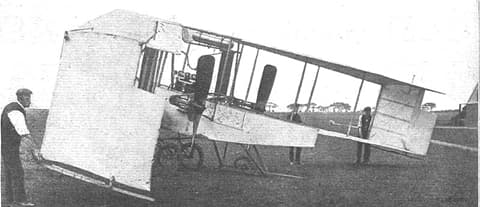
https://en.wikipedia.org/wiki/File:Dunne_D5.jpg
The first flight in the English summer of 1910 was a success, after Dunne took off downhill and into the wind. Later that year, he flew D.5 at the Royal Aero Club with his hands off the controls ‘for a considerable period’, while writing a note on a piece of paper someone else provided for the purpose.
The specification for the Dunne D.5 was as follows:
- Length 20 ft, height 11 ft, wingspan 46 ft, wing area 527 sq ft
- Gross weight 1,550 lb, one crew member (pilot)
- Green Engine Co. 60 hp motor, 45 mph maximum speed
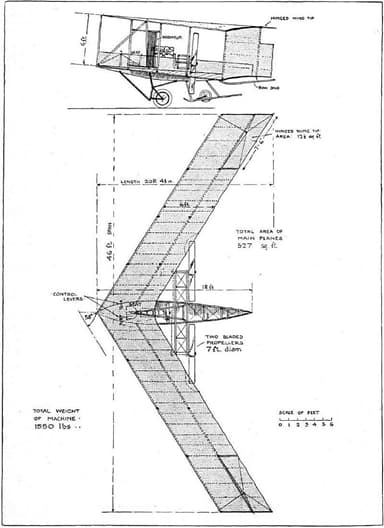
https://en.wikipedia.org/wiki/Dunne_D.5#/media/File:Dunne_D5_plans-Flight_june_1910.jpg
Henri Fabre Takes Off On Water for the First Time (March 1910)
Henri Fabre was an aviator born into a prominent French family of ship owners, but who preferred to explore the new form of transport, fixed wing powered aircraft. He studied airplane and propeller designs.
Then he patented a system of flotation devices, which he used when he took off from the surface of the Etang de Berre Lake on 28 March 1910. Historians call this first seaplane the Fabre Hydravion meaning ‘water flyer’ because Henri apparently did not give it a name.
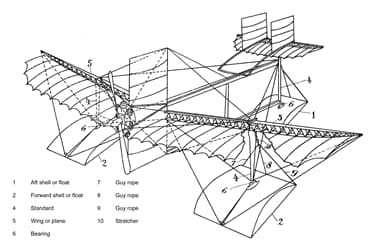
https://www.waterbird.org.uk/henri-fabre/
It took four years for Henri Fabre to develop his Hydravion, assisted by a mechanic and a naval architect. He chose a canard configuration with a small wing placed ahead of the min one, and two girders forming the fuselage. The pilot sat astride the aircraft supported by three floats when resting on the water.
Fabre first flew successfully on March 28, 1910 when it travelled for 1,600 feet through the air. Three successful flights followed and he had flown a distance of 3.5 miles within a week.
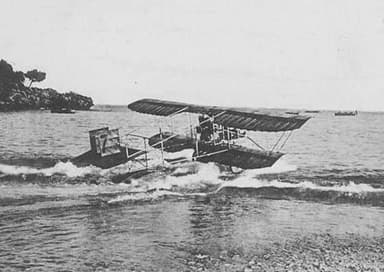
http://www.association-francaise-hydraviation.fr/construction-hydravions
However, Henri Fabre had no flight experience and Hydravian was badly damaged on a subsequent occasion. The restored Hydravion is on display at the Musée de l’air et de l’espace in Bourget, Seine-Saint-Denis, France.
The specification was as follows:
- Length 27 ft, height 12 ft, wingspan 45 ft, wing area 183 sq ft
- Empty weight 838 lb, gross weight 1,047 lb
- Gnome Omega rotary 7-cylinder piston engine 50 hp, max speed 55 mph
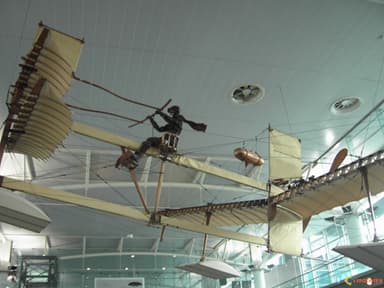
https://www.visoterra.com/index.php?component=photo&task=showPhotoGrandformat&idPhoto=10311
Caproni Experimental Airplane Flies in Italy (May 1910)
Italian aviation pioneer Gianni Caproni had previously collaborated with Romanian aeronautical engineer Henri Coandă on sailplane designs. Then in June 1909 he decided to build a design that they had previously worked on together. This would become the first aircraft manufactured entirely in Italy. NOTE: This aircraft should not to be confused with the 1914 bomber Caproni Ca.1.

https://en.wikipedia.org/wiki/File:Caproni_Ca._1_and_Caproni_works_in_Arco,_Trento,_1909-1910.JPG
Caproni Ca.1 was a single-engine biplane, with an uncovered honeyberry wooden truss using aluminum connections to join the pieces. The wings connected to this fuselage near the nose, while there was a tail assembly at the rear. Flight controls were as follows:
- The horizontal and vertical stabilizers were twin aerodynamic surfaces
- The wings were fitted with ailerons and had a conventional structure
- The elevator in the tail assembly connected to a yoke the pilot controlled
- A patented device allowed the angle of incidence of the wings to vary
- The tail planes were similarly adjustable to harmonize with the wings.
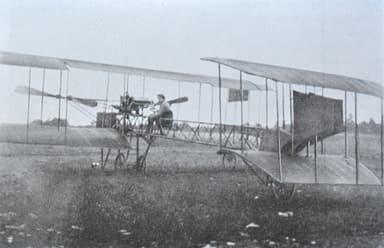
https://en.wikipedia.org/wiki/File:Caproni_Ca.1,_1910.JPG
Caproni Ca.1 took off at the first attempt on May 27, 1910, and flew straight and level with Ugo Tabacchi at the controls. However, the Veronese-born Trentine chauffeur who had recently joined Caproni’s team had never attempted a landing before.
The impact with the ground was violent, and the aircraft sustained serious damage. However, Gianni Caproni was able to repair it for taxiing training and other ground maneuvers. But this particular version never flew again.
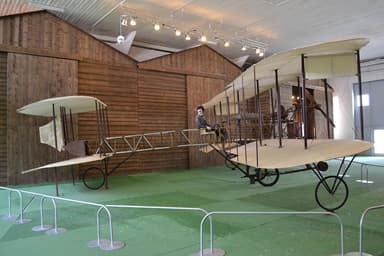
https://en.wikipedia.org/wiki/Caproni_Ca.1_(1910)#/media/File:Caproni_Ca.1_at_Volandia_(3).JPG
The specification was as follows:
- Length 32 ft, height 11 ft, wingspan 34 ft, wing area 409 sq ft
- Crew 1, empty weight 1,210 lb, gross weight 1,430 lb
- 4-cylinder Miller fan engine , 25 hp, one crew (pilot)

https://en.wikipedia.org/wiki/File:Caproni_Ca.1_Miller_engine_at_Volandia.JPG
International Air Conference on Border Crossings (June 1910)
The French government was concerned about the lack of control over foreign nations flying over its administrations. Accordingly, it called an International Air Navigation Conference in Paris during May 18 to June 29, 1910.
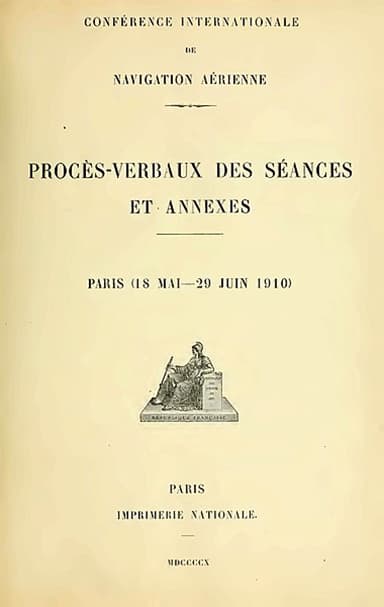
https://en.wikipedia.org/wiki/File:Proc%C3%A8s-verbaux_des_s%C3%A9ances_et_annexes;_Paris,_18_mai-29_juin,_1910.jpg
Opinion was divided between the participants. Some nations desired a wide freedom of movement for aircraft. While others, for national security reasons wished to control which aircraft crossed into their countries. The conference deadlocked and went into recess. The First World War took it off the table.
Charles Rolls Completes English Channel Round Trip (June 2010)
Charles Rolls is best known for his role in establishing the Rolls-Royce motor company. But he was also a keen aviator who met his death on July 12, 1910 when the tail of his Wright Flyer broke off during a flying display.
However, he made his mark a few weeks earlier on June 2nd of 1910, when he completed a non-stop, double crossing of the English Channel in 95 minutes in a Wright Flyer’ including the return trip.

https://www.autoevolution.com/news/charles-rolls-once-crossed-the-english-channel-from-uk-to-france-and-back-144335.html
Rolls prepared for any difficulties over the water by attaching four large buoyancy bags filled with compressed air lashed to the machine’s undercarriage. He took off from Dover, England, climbed to 900 feet and headed for Sangette in France, where he dropped three weighted envelopes with messages 45 minutes later.
Then he turned the Wright Flyer in the return direction, and headed back to Dover to complete the 31.5 mile round flight. When he arrived he circled three times around ancient Dover Castle, before landing to cheers from crowds packing the sea front, the cliffs and the pier.
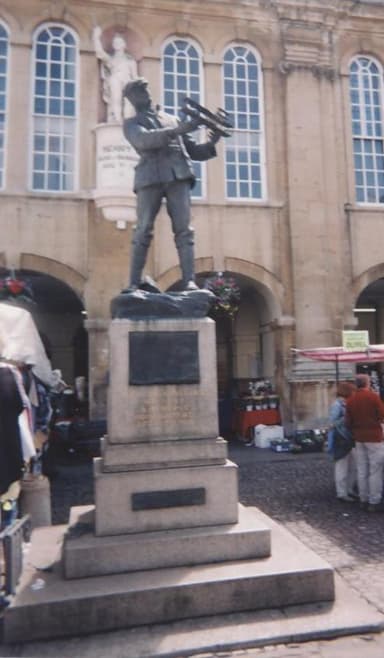
https://en.wikipedia.org/wiki/Charles_Rolls#/media/File:MonRolls.jpg
Short Brothers Successfully in the Air by June 1910
The Short Brothers’ Improved S.27 became the backbone for early pilot training in the British Admiralty and Naval Wing of the Royal Flying Corps. It’s unclear when the first flight of the Improved S.27 took place. However, Flight magazine recorded several successful flights had been made by June 4, 1910.
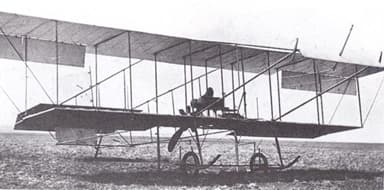
https://en.wikipedia.org/wiki/File:Improved_Short_S.27.jpg
The general specification was as follows:
- Length 42 ft, wingspan 46 ft, wing area 517 sq ft
- Empty weight 1,000 lb, gross weight 1,540 lb, crew 2
- Gnome Omega 7 cylinder air-cooled rotary engine 50 hp
- Max speed 48 mph, wing loading 2 lb per sq ft
Vlaicu Flies Aircraft with Italian Military Potential (June 1910)
Aurel Vlaicu was a Romanian engineer and inventor. He learned to fly gliders and then experimented with rubber-band-powered model aircraft. Then he flew his first real powered, fixed wing-aircraft on June 17, 1910, after taking off from Cotroceni airfield in western Bucharest, Romania.

https://en.wikipedia.org/wiki/File:Aurel_Vlaicu_first_flight.jpg
Aurel Vlaicu demonstrated his aircraft to the Italian Military Commission during August 1910. The officials were impressed by the aircraft’s performance, and wrote (paraphrased) as follows:
‘This aircraft could be valuable for reconnaissance and hence a useful military machine. We believe the War Department should support further development. And we should enter into negotiations with the author to achieve the desired result.’
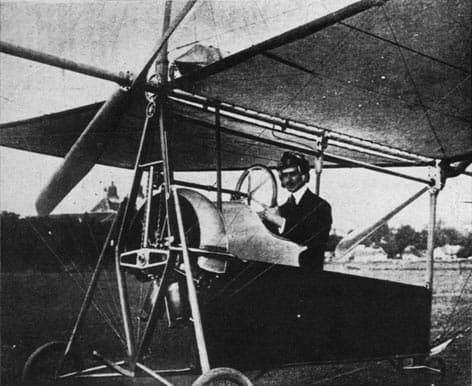
https://commons.wikimedia.org/wiki/Category:A_Vlaicu_I#/media/File:Aurel_Vlaicu.jpg
The specification was as follows:
- Length 29 ft, height 13 ft, wingspan 32 ft, wing area 270 sq ft
- Weight 661 lb, 2 coaxial, counter-rotating 2-bladed propellers 10 ft diameter
- Gnome Omega air-cooled rotary piston engine, 50 hp
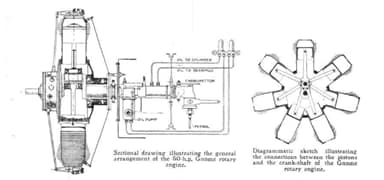
https://en.wikipedia.org/wiki/Gnome_Omega#/media/File:Gnome-GA_section.png
Butler Ames Attempts to Take Off From a Ship (July 1910)
The principles of heavier than air flight were by no means settled, at least according to American congressman, engineer, soldier and businessman Butler Ames. He convinced the U.S. Navy he had invented a new type of airplane that harnessed the Magnus Effect.
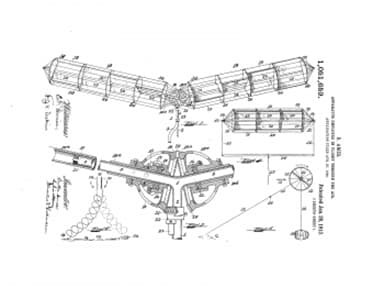
https://www.navalhistory.org/2016/10/28/naval-aviation-oddity-the-butler-ames-aerocycle
The Magnus Effect is present in a spinning cricket ball that curves away from its initial arc. Butler Ames’ experiment was the first of several attempts to create lift with a rotating cylinder at the front of a wing, allowing flight at lower horizontal speeds.
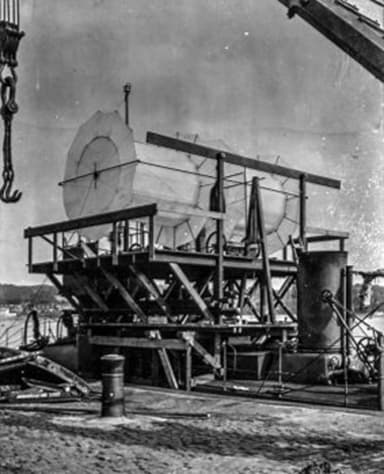
https://www.navalhistory.org/2016/10/28/naval-aviation-oddity-the-butler-ames-aerocycle
The United States Navy torpedo boat Bagley embarked the machine on a day in July 1910. She departed the U.S. Naval Academy in Annapolis, Maryland, and made her way down the Severn River to Chesapeake Bay.
The New York Times reported the Aerocycle did lift off its wooden platform atop the torpedo boat behind the bridge. But whether it actually flew is another matter, now lost in the shifting sands of time.
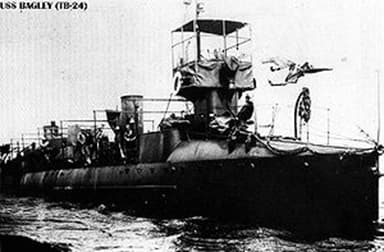
https://en.wikipedia.org/wiki/USS_Bagley_(TB-24)#/media/File:USS_Bagley_(TB-24).jpg
Bristol Boxkite Biplane Leads to Military Production (July 1910)
George White was the son of a painter / decorator and lady’s maid who began investigating flight at age 54, after amassing a fortune as stockbroker and electric transport provider. He traveled to France in 1908, and 1909 where he studied Wright aircraft in action.
White founded the British and Colonial Aeroplane Company (later known as the Bristol Aeroplane Company) after he returned to England. He plunged into developing the Bristol Boxkite (Zodiac) airplane that would become one of the first aircraft types to be built in quantity.
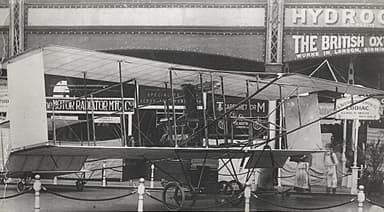
https://en.wikipedia.org/wiki/File:Zodiac-Olympia.jpg
The Boxkite was a two-bay biplane, with an elevator carried on booms in front of the wings, and an empennage tail section consisting of a pair of fixed horizontal stabilizers. The upper bearing was an elevator, while dual rudders were on booms behind the wing.
There were single-acting ailerons on both upper and lower wings for lateral control. Control cables pulled them down only, relying on the airflow to return them to the neutral position again.
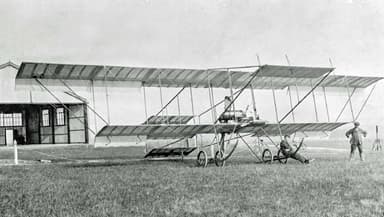
https://www.baesystems.com/en/heritage/bristol-boxkite
The aircraft, believed to be built to order by Zodiac Aerospace in France, managed a single hop on July 31, 1910 before being damaged in a subsequent attempt. However, modified versions were highly successful as trainers for the Air Battalion and Royal Flying Corps.
In total, 78 were built for a price of £1,000 including engine. They were sold to air forces in Australia, Bulgaria, Romania, Russia, South Africa, Spain, Sweden and the United Kingdom.
The specification of the extended military version was as follows:
- Length 38 ft, height 11 ft, wingspan 47 ft, wing area 517 sq ft
- Crew 2, empty weight 900 lb, gross weight 1,150 lb
- Gnome Omega 7-cylinder air-cooled radial piston engine, 50 hp
- 2-bladed fixed-pitch pusher propeller, max speed 40 mph

http://www.aviastar.org/air/england/bristol_boxkite.php
First Discharge of Military Firearm from Aircraft in Flight (Aug 1910)
Jacob Earl (Jake) Fickel was a general officer and an instructor of aviation in the United States Air Force, who rose to the rank of major general. Unbelievable that it may sound with the wisdom of hindsight, there was a popularly accepted theory an airplane would break up due to a gun’s recoil if fired from the air.
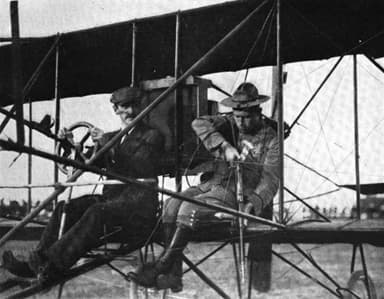
https://en.wikipedia.org/wiki/File:Jacob_Earl_Fickel_with_Glenn_Curtiss_1910.jpg
Jacob Fickel conducted his experiment on August 20, 1910 with aviation entrepreneur Glenn H. Curtiss at the controls. He discharged his rifle over Sheepshead Bay Race Track near New York City without any disruption to the flight. This was a significant step in the development of military aircraft.
First Solo Airplane Flight by Blanche Stuart Scott (September 1910)
Blanche Stuart Scott may have been the first American female aviator. Earlier in that year 1910 she became the second woman to drive an automobile across the United States, and the first driving westwards from New York City to San Francisco, California. Willys-Overland provided the vehicle but she did all the driving.

https://en.wikipedia.org/wiki/File:Blanche_Scott%27s_Lady_Overland_motor_trip_stopping_in_Toledo_-_DPLA_-_63eed897f5397fb20a55f7e0c4e9dc2f.jpg
Her exploit caught the attention of aviation pioneer Glenn Curtiss, and event organizer Jerome Fanciulli who was on a mission to prove pilot-directed, motorized flight had become reality. The two men offered Blanche Stuart Scott free flying lessons in Hammondsport, New York.
She was Curtis’ only female trainee. He fitted a limiter on the throttle of Scott’s airplane to prevent it gaining enough speed to become airborne, while she practiced taxiing on her own.
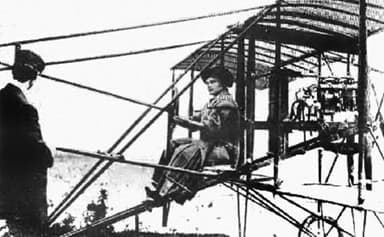
https://en.wikipedia.org/wiki/File:BlancheScott2.jpg
Then, on September 6, 1910 the unexpected happened. The limiter may have moved, or a gust of wind caused the airplane to take off without warning. Whatever the case, Scott flew to an altitude of forty feet before executing a gentle landing.
The intrepid lady became a member of the Curtiss exhibition team famous for flying upside-down, and performing ‘death dives’ from an altitude of 4000 feet and suddenly pulling up only 200 feet from the ground.
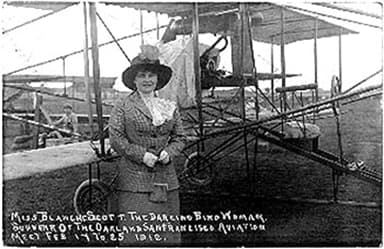
https://en.wikipedia.org/wiki/Blanche_Scott#/media/File:BlancheScott4.jpg
Bessie Raiche Follows Through with a Solo Flight (Sept 1910)
Bessie Raiche was an American businesswoman, dentist, and physician. Blanche Stuart Scott may have pipped her to the post on September the 6th. However, when Bessie first took to the air on September 16, 1910 the difference was she had received no flying instruction.
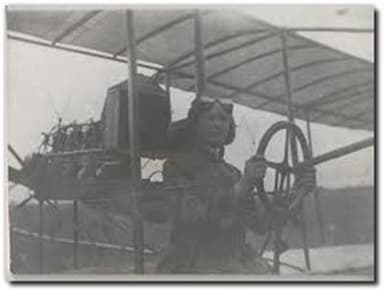
https://simanaitissays.com/2017/04/14/bessie-raiche-first-american-woman-to-fly-and-rather-more/
Bessie Raiche was the first woman pilot to be accredited by the Aeronautical Society of America at the time. However, whether she was first or second to do this is in doubt. Many people believe Frenchwoman Raymonde de Laroche deserves the title for she received her pilot’s license on March 8, 1910.
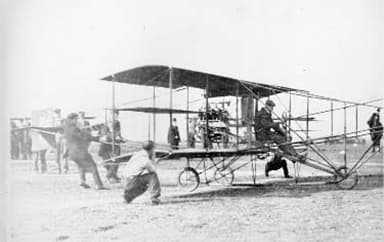
https://shells-tales-sails.blogspot.com/2016/04/r-is-for-bessica-raiche-pioneer-women.html
Blacksmith Andrew Blain Baird and His Monoplane (Sept 1910)
The days of aviation pioneers were melting fast away, as big money chased commercial and military applications. Scottish blacksmith Andrew Blain Baird wanted to own an airplane, but how could the son of a fisherman and a cottage handloom worker on the Isle of Bute possibly afford his dream?
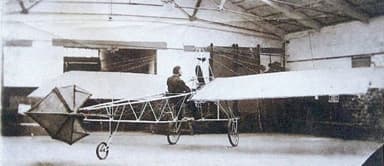
https://www.bairdofbute.co.uk/the-baird-monoplane/
He would build the aircraft himself, the daring thinker decided in the spirit of innovation. Baird read every edition of Flight magazine he could lay his hands on. He also corresponded with early aviators Louis Bleriot and S. F. Cody, and exchanged information about construction of aircraft and their flight.
Baird also visited England’s first ever Aviation Week in Blackpool in October 1909. And then, suitably inspired with knowledge he set about constructing his aircraft comprising a complex tubular steel forward frame, and triangular wire braced rear section made with bamboo longerons and tubular steel spacers.
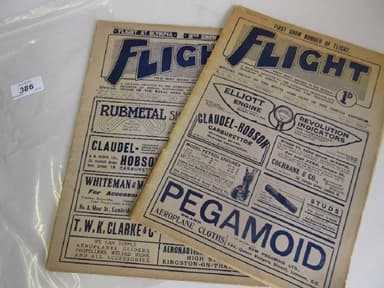
https://www.liveauctioneers.com/item/53508348_two-early-editions-of-flight-magazine-no-63-no
Flight magazine was in attendance on the day of Baird’s first flight. Their reporter wrote ‘Mr Baird was seated in the machine and on the engine being started the plane travelled along the sands at good speed.
‘Naturally, on clearing the ground, the swerving influence of the axle ceased and the influence of the steering wheel brought the machine sharply round to the right causing it to swoop to the ground.’ they reported..
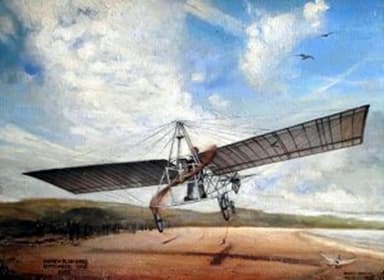
https://www.bairdofbute.co.uk/the-baird-monoplane/
‘The contact was so sharp that the right wheel buckled and the right plane suffered some abrasion by scraping along the beach.’ Later, Tommy Sopwith viewed the aircraft and obtained permission to incorporate some features in his designs. These may or may not have been the following that distinguished the monoplane:
- Wide-tracked undercarriage
- A canvas pilot’s seat
- Joystick-wheel for steering
- 71-inch diameter propeller
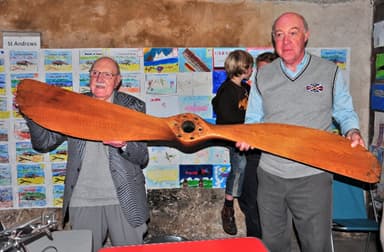
https://www.bairdofbute.co.uk/the-baird-monoplane/
The specification of the aircraft was further as follows:
- Length 25 ft, wingspan 29 ft, weight 380 lb
- 4-cylinder, air-cooled engine with water-cooled valves.
Higher in the Sky the Risk Is Too Great for Géo Chávez (Sept 1910)
Many of the heroes of early aviation were young men in their twenties, who seemed to know no fear. Peruvian Jorge Antonio Chávez Dartnell was one of these, although his many honors are in his nickname Géo Chávez
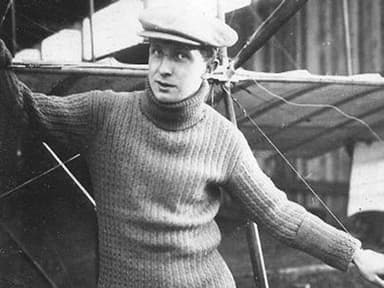
https://alchetron.com/Jorge-Ch%C3%A1vez
The Aero Club of Italy had offered a $20,000 prize for the first aviator to fly across the Alps mountain range alive. That wording suggests they knew the feat was dangerous, but Géo Chávez was up to the challenge.
On September 23, 1910 the weather was amenable and his Bleriot XI aircraft prepared. Before departing he remarked ‘Whatever happens, I shall be found on the other side of the Alps’ according to bystanders.
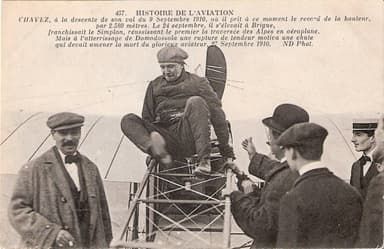
https://twitter.com/ron_eisele/status/1043827912376561664
He took off from Ried-Brig in Switzerland, and made his way through the Simplon Pass heading for Domodossola in Italy 40 miles away by road. All went according to plan as he ascended to an altitude of 7,200 feet.
Then the wings of his fragile aircraft broke, and he fell to the ground as he descended to his destination, Domodossola. It is possible the aircraft was damaged previously, but not adequately repaired. His last words were ‘Higher Always Higher’ according to his friend and fellow aviator Juan Bielovucic.
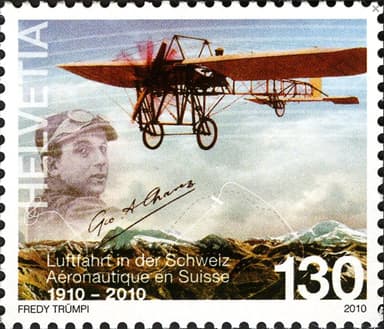
https://colnect.com/en/stamps/stamp/191868-Geo_Chavez-Aviation-Switzerland
Henri Coandă Builds First Motor Jet Aircraft (October 1910)
Henri Coandă was a Romanian inventor widely recognized in his country as the creator of the first air-powered aircraft engine. Although many others dispute this, because of the lack of evidence an actual flight took place.
A modern motor jet engine receives air under pressure from a conventional motor driving a compressor. Fuel is fed to the combustion chamber which mixes with the air and ignites, causing the gas to expand and escape from the exhaust at high velocity. This can amplify the energy from a traditional propeller as in this diagram.
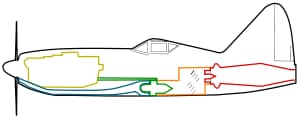
https://en.wikipedia.org/wiki/Motorjet#/media/File:WRDK.svg
However, Henri Coandă’s motor jet engine varied from the modern version in that there was no secondary combustion. Instead, the 920-pound aircraft would have relied on its centrifugal blower to draw it forward.
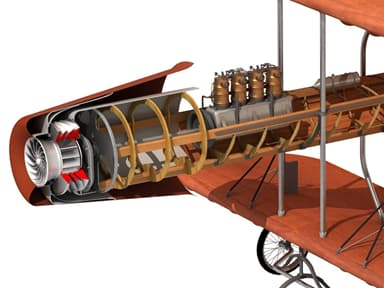
https://grabcad.com/library/coanda-1910-1
The usual aircraft attracted considerable interest at the Second International Aeronautical Exhibition in Paris in October 1910, where it was on static display. After that, its future is uncertain, although Henri Coandă did claim many years later to have made a single brief flight in December 1910, crashing just after lift-off with the aircraft consumed by fire.

https://en.wikipedia.org/wiki/Coand%C4%83-1910#/media/File:Coanda_1910.png
Coandă-1910 may have the first impression of propelling an aircraft by compressed air. Whatever the case, its specification was as follows:
- Length 41 ft, wingspan 33 ft, wing area 350 sq ft, gross weight 920 lb
- 4 cylinder, inline, water-cooled 50 hp Antoinette engine driving a compressor
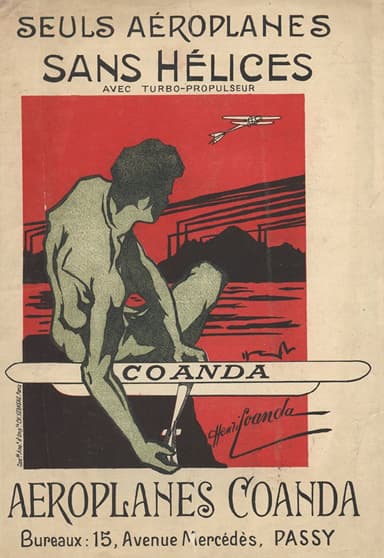
https://en.wikipedia.org/wiki/Coand%C4%83-1910#/media/File:Coanda-1910_brochure.jpg
Roosevelt Takes First U.S. Presidential Flight (October 1910)
U.S. President Theodore Roosevelt flew with exhibition pilot Arch Hoxsey at St. Louis on 11 October, 1910. However, he was only the second world leader to do so, because former Italian Prime Minister Sidney Sonnino flew with Wilbur Wright the previous year at Centocelle near Rome. Hocksey used a Wright Type AB aircraft for the demonstration, which was by all accounts successful.
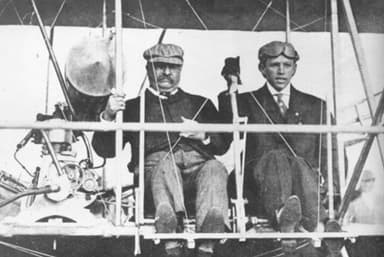
https://en.wikipedia.org/wiki/Archibald_Hoxsey#/media/File:Theodore_Roosevelt_and_Archibald_Hoxsey_(1910).jpg
Ely’s First Shipboard Take-Off and Landing (November 1910)
Eugene Burton Ely was an aviation pioneer, and the first pilot to fly to, and from a U.S. naval vessel although this was on separate occasions. He was something of a ‘dare-devil’ pilot, having crashed the first aircraft he borrowed, one of the earliest Curtis four-cylinder biplanes. However, he bought the wreck, fixed it up and learned to fly.
Ely and Curtis met Captain Washington Chambers in October 1910. This was after the Secretary of the Navy appointed Curtis to investigate military uses for aviation within the Navy. Ely took off from USS Birmingham in a Curtis Pusher aircraft on November 14, 1910.
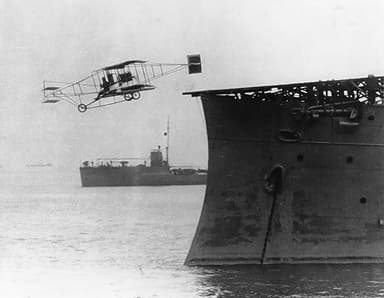
https://en.wikipedia.org/wiki/File:First_airplane_takeoff_from_a_warship.jpg
The aircraft fell sharply, and the wheels touched the water before rising. Discretion was the better part of valor this time, because Ely’s goggles were covered with spray and so he promptly landed on a beach.
Two months later, Ely successfully landed his aircraft on a special platform on USS Pennsylvania on January 18, 1911. This was the first occasion of using a tail-hook system. He told a reporter ‘It was easy enough. I think the trick could be successfully turned nine times out of ten.’
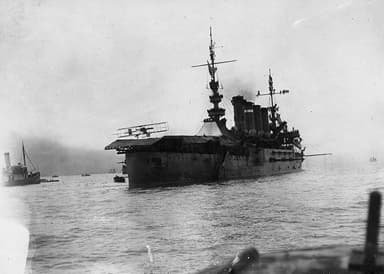
https://en.wikipedia.org/wiki/Eugene_Burton_Ely#/media/File:USS_Pennsylvania_-_First_airplane_landing.jpg
The Martin Handasyde No.3 Dragonfly Monoplane (November 1910)
H P Martin and George Handasyde were two British aviation enthusiasts who formed a partnership in 1908. Their enterprise was successful, and their Martinsyde company became Britain’s third largest aircraft manufacturer during World War One, with flight sheds at Brooklands and a large factory in nearby Woking.
Their first aircraft, the Martin-Handasyde No.3 was an early monoplane design of which they only built one. Their ‘Dragonfly’ as they called it was similar to the Antoinette monoplanes, with a slender wood-covered triangular section fuselage, and tapered wings which were braced by mid-span vertical kingposts.
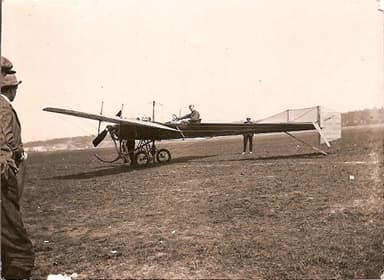
https://en.wikipedia.org/wiki/File:Martin-Handasyde_4B_Dragonfly.jpg
Lateral control was obtained by wing warping. The angle of incidence of the wings varied from 5° at the wing root to zero at the tip. A pair of wheels on a cross axle supplemented by a forward-projecting curved skid formed the undercarriage.
The Martin-Handasyde No.3 first flew at Brooklands in November, 1910. British pioneer stunt pilot Graham Gilmour flew it a number of times until a mid-air structural failure on February 17, 1912 caused a fatal crash.
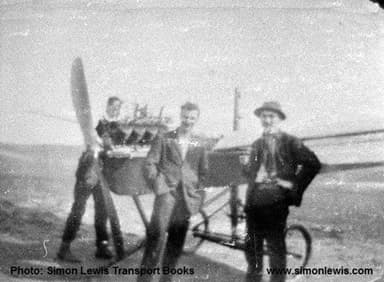
https://shop.simonlewis.com/martin-handasyde-no3-photowith-martin–handasydec1910-25761-p.asp
The general characteristics of the aircraft were as follows:
- Length 28 ft, wingspan 32 ft, wing area 179 sq ft, crew 1
- Empty weight 550 lb, 2-bladed, 7 ft diameter propeller
- Power 1 × J.A.P. 40 hp engine, max speed 60 mph
Glenn Curtiss Establishes Commercial Presence (December 1910)
Aviation pioneer Glenn Curtiss began developing aircraft in 1908 under the wing of Alexander Graham Bell’s Aerial Experiment Association. However, he set off on his own in 1909 after the association disbanded. His first step was to form the Herring-Curtiss Company with aviation pioneer Augustus Herring.
Glenn Curtiss moved out on his own after the two aviators parted in 1909. He set up shop in San Diego, where he taught others to fly while he continued to develop his Model D biplane with ailerons between the wings. Much more was to follow after that.
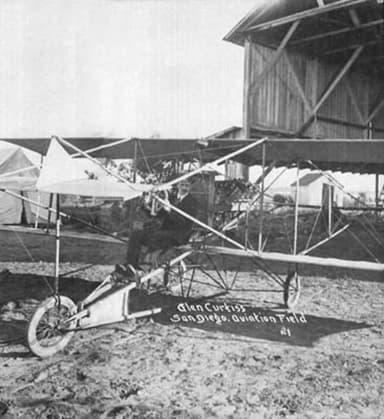
https://sandiegohistory.org/journal/1979/january/curtissimages/
Imperial Japanese Army Tries Its Wings (December, 1910)
On December 19, 1910 Japanese lieutenant general Baron Yoshitoshi Tokugawa made the first heavier-than-air flight in Japan piloting a Farman III biplane. He had spent time in France the previous year as a military attaché, studying aeronautical engineering and military applications for the use of aircraft in combat.
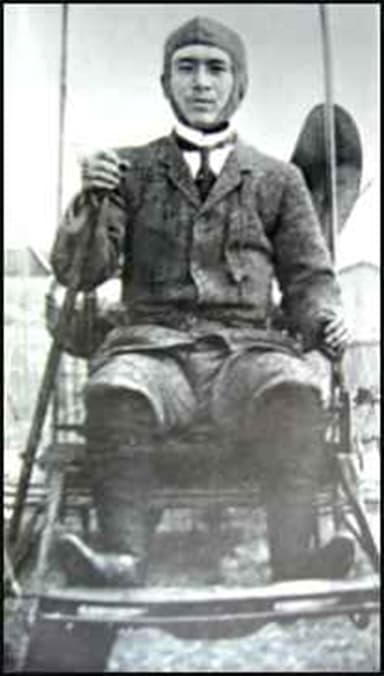
https://en.wikipedia.org/wiki/File:Tokugawa_Yoshitoshi.jpg
Yoshitoshi Tokugawa made his first flight from homeland soil on December 19, 1910 over Yoyogi Parade Ground in Tokyo’s Shibuya Ward. His efforts bore fruit the following year when Japan imported three more aircraft, and built its own improved version of the Farman III biplane under his guidance.
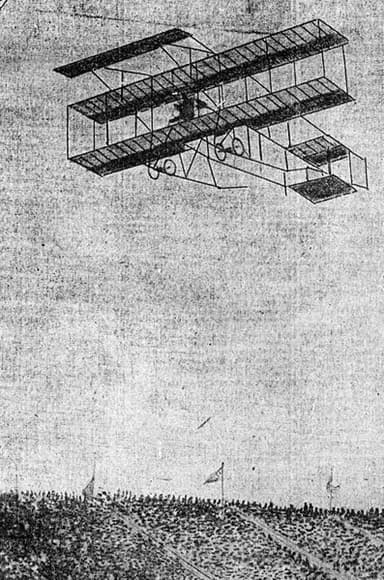
https://en.wikipedia.org/wiki/File:1910inaviation-farman3biplane-losangeles.jpg




